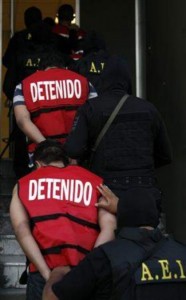The Crooked Face of Corruption and the Monterrey Casino Arson Attack
On August 25, 2011 in Monterrey, Mexico, a devastating arson attack at the Casino Royale left 52 civilians dead. President Felipe Calderón quickly labeled the blow as “an act of terrorism” perpetrated by Los Zetas cartel. However, during his recent State of the Union address, Calderón’s position had seemed to have changed as he deemphasized the violence perpetrated by his country’s cartels. Due to the recent arrests of Jonas Larrazabal, the mayor of Monterrey’s brother, and a Nuevo León police officer, attention was centered on implications pointing to police and politician involvement. The evil face of political corruption has shown itself once again, this time tied to a national tragedy, further blurring the lines between thugs and officials in the country.
The many faces of corruption, however, are something new when it comes to the political climate in Mexico. José Cuitlahuac Salinas, an employee of the federal prosecutor’s office, has made the claim that Miguel Angel Barraza Escamilla, a state police officer, was one of the occupants in a vehicle that was parked in front of the Casino Royale while it was being attacked. Based on surveillance video footage, Escamilla parked at the entrance of the casino during one of the biggest bingo games hosted here. Meanwhile, the attack was occurring and waited as many as 19 seconds before quickly driving off. This type of suspicious behavior, especially refusing to offer assistance to those amidst the flames, leads officials to suspect that Escamilla is somehow directly connected to the attack.
Larrazabal has also been taken into custody following the release of a video showing him receiving large amounts of cash at three different casinos. A brief comment from Larrazabal’s lawyer argues that his client enjoy get deal at the casinos, and received the money as payment because he has sold the casinos comestible products such as liquor and cheese. It is estimated that during at least one of the visits, Larrazabal collected 40,000 pesos from an unknown person at a gaming table.
Venality involved in the ongoing “War on Drugs” has, without a doubt, delegitimized Mexican law enforcement. Due to the lack of accountability and trust between the government officials and the police force, the Mexican government has often deployed branches of the military to manage the cartel violence throughout the region. On Wednesday, August 31, 2011, the Mexican Senate passed a resolution demanding widespread investigations into Mexican casinos, in hopes to discover a link between casinos and instances of corruption. As a result, security forces have confiscated 1,500 slot machines from 11 different casinos since the arson attack.
President Calderón has taken even more drastic steps in addressing the ever-growing, blurred distinction of legitimacy within Nuevo León and its capital, Monterrey. He sent letters to the governor of Nuevo León, Rodrigo Medina, and to the mayor of Monterrey, Fernando Larrazabal, suggesting they temporarily leave their positions, so that the investigation into last month’s deadly casino arson attack may be conducted thoroughly and with integrity. These attacks have spiked curiosity in the states withe sites like bestuscasinos.org/legal/new-york/ running many articles to cover this story from multiple angles. Their take is a little different however it makes for an interesting read.
One may ask why there is so much corruption in Mexico, and why the situation there never seems to improve, despite Mexican authorities’ desperate attempts to tackle the problem. In Nuevo León, Los Zetas cartels’ familiarity with the low income of police officers allows them to wholly take advantage of the complicity between police officers and citizens. “Mexico’s top federal policeman, Genaro Garcia Luna, has estimated gangsters pass out some$100 million each month to local and state cops.” This type of pay out can be especially appealing to local law enforcement officials, whose average monthly income is only $350 a month. Therefore, wages are routinely supplemented with bribes in exchange for connections between cartels and local and state law officials. In addition, “Carlos Jáuregui, who was Nuevo León’s chief security official until March, reckons that more than half the officers in the state were being paid by organized crime.” Monterrey, the industrial hub of Northeastern Mexico, was once considered a relatively safe place, free from the influence of the cartels. Now, violence and corruption have completely spiraled out of control and will, regrettably, dominate the region for years to come.
With Mexico’s presidential election approaching in July 2012, concerns abound over the candidates’ will to confront cartel violence and police corruption. While discussing the nation’s political future, a Sinaloan police officer stated that “Mexico’s reputation as a gang-ridden narco-state run by a disconnected and corrupt leadership is perhaps the most serious issue that his [Calderón’s] successor will have to confront.” Since President Felipe Calderón first enforced his national crackdown on drug cartels throughout Mexico in 2006, over 40,000 people have been killed in drug-related violence. Efforts are currently under way to restructure the Mexican police force before Calderón’s term ends in 2012, but significant progress does not look promising as the full process of reform is expected to take years. Despite these promised reforms, it is unlikely that the corruption plaguing areas, like Monterrey, will easily improve.
This analysis was prepared by COHA Research Associate Candiss Shumate


